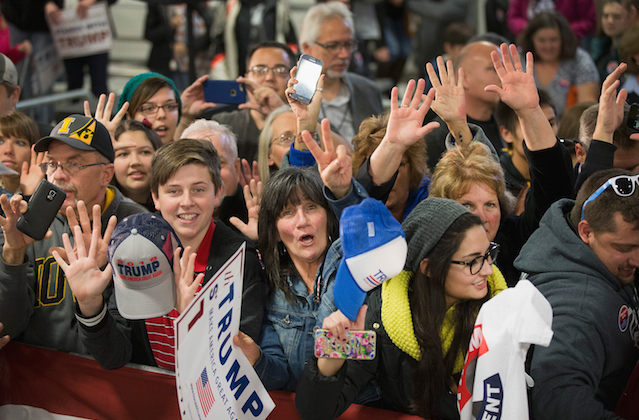Donald Trump and the Disaffected, White, Working Class Voter

I live and work in a gentrifying but still predominantly working-class, Black neighborhood in Philadelphia with a large number of African-American and immigrant Muslims. So in my daily interactions at the grocery store, the library or a local restaurant, I don’t really feel the rising surge of anti-Muslim sentiment in our country. Instead, I just feel deeply saddened by Donald Trump’s proposed ban on Muslims entering the United States and statistics showing that 76 percent of Republicans and 43 percent of Democrats believe that Islam is “at odds with American values and way of life.”
Trump’s base is largely made up of White working class voters from the Midwest and without a college degree. They blame people in my neighborhood for their own economic plight and fear Islam, my religion, for their physical safety. It makes little sense on the surface. But the plague of racial division always threatens to infect the American consciousness with ideas of divide and conquer.
Trump’s strategy—and the strategy dominating most of the 2016 Republican presidential campaigns—comes from a playbook as old our country’s founding. White paranoia of people of color and immigrants has always fueled violence and inequality in this country. Trump is simply capitalizing on the real grievances held by working class White Americans about our exceedingly unfair economic system. As writer Max Berger put it in his late November Nation piece about White terrorism in the United States: “The growing proto-fascist, white-supremacist movement in the Republican Party is preying upon non-rich white people who are literally dying of despair, turning to drugs and suicide to deal with a reality they can’t bear, and a society they believe doesn’t care for them… [W]hite people are right that they are under attack—they’re just pointing to the wrong culprits.”
Trump is seeking to activate these millions of White Americans, many of whom feel that neither major party speaks to their plight. His high poll numbers among White voters in the Midwestern Rust Belt show how attractive he is to people in this region who are still dealing with the fallout of the life-changing economic collapse of 2008. Just as those who came before them did, many of these White voters blame their woes on people of color and immigrants whom they accuse of “taking over the country.” When Trump declares he will “make America great again,” he strikes the heart of this demographic.
What's most terrifying to me about the success of Trump’s cynical, divisive strategy is that it mirrors trends in public opinion that began in the 1970s under Richard Nixon’s so-called Southern strategy. That strategy used both overt and subtle racist appeals to bring White working class voters into the Republican Party.
And the levels of polarization in Congress today match those right before the Civil War, when abolitionists pushed Republicans to end slavery and White racists pushed Democrats to defend the horrific system in the name of states’ rights. There was no compromise to be had on either side of that question.
Today the political poles are again moving farther and farther apart. An angry base of White, working and middle class voters emboldened by the Tea Party movement, Fox News and Trump are pulling Republicans in the direction of xenophobia and racism which Millennial movements for racial and economic justice and immigrant and LGBTQ rights are pushing Democrats toward a more inclusive society. Just like before the Civil War, these differences concern central, competing ideas about the heart of the United States. They explain why common sense reforms on gun violence, immigration, welfare, policing and finance have virtually no chance in passing in our broken system.
In the spring of 1965, at the end of the voting rights march from Selma to Montgomery, Rev. Martin Luther King Jr. said of racial divisions between Whites and Blacks:
[It] is very important to see the roots of racism…through their control of mass media, they revised the doctrine of white supremacy. They saturated the thinking of the poor white masses with it…It may be said of the Reconstruction era that the southern aristocracy took the world and gave the poor white man Jim Crow. He gave him Jim Crow. And when his wrinkled stomach cried out for the food that his empty pockets could not provide, he ate Jim Crow, a psychological bird that told him that no matter how bad off he was, at least he was a white man, better than the black man.
That bird continues to travel across America. Fifty years after the Voting Rights Act passed, Rev. William Barber II, the president of the North Carolina NAACP and a leader of the Moral Mondays movement put it this way: “They teach whites that their problems are due to folks getting things that they should not have…the goal is to drive a wedge right down the middle of the soul of America.”
Sooner or later, people in a deeply divided America are going to face moment of reckoning about what kind of country we want to live in. Democrats seem to be waiting for Citizens United to be overturned and for minority-majority demographic changes to start in 2020. But even with campaign finance reform and a new electorate made up of left-leaning voters, Congress is constitutionally set up to over-represent White rural interests—especially through the Senate. Meanwhile Trump's Republican Party pits White working class voters against the turning demographic tide of the country. So without a major shift in mainstream public opinion; White working class voters finding a new political home outside the right-wing insurgence; or a real transformation of our political system, the United States will head into a deeper racial conflict—one that could end up in a very dangerous place.
Waleed Shahid is Philadelphia-based writer and the political director of Pennsylvania Working Families Party. He is a movement-building trainer with Momentum, tweets at @waleed2go and is a regular contributor to Colorlines.
